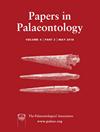A possibly deep branching artiopodan arthropod from the lower Cambrian Sirius Passet Lagerstätte (North Greenland)
IF 2.2
2区 地球科学
Q1 PALEONTOLOGY
引用次数: 0
Abstract
Artiopoda was a diverse group of Palaeozoic euarthropods that proliferated in the early Palaeozoic, epitomized by the ubiquitous trilobites. Their possible phylogenetic position outside mandibulates and chelicerates offers the potential for understanding the evolution of euarthropods in more detail. However, this opportunity remains unexploited given that identification of deep‐splitting artiopodans remains to be fully explored. Here, we describe a new non‐trilobite artiopodan from the lower Cambrian Sirius Passet Lagerstätte, North Greenland. Thulaspis tholops gen. et sp. nov. is a large species with a broad, domed head shield, followed by a trunk consisting of 15 thoracic tergites and a small pygidium, giving the body an ovoid appearance when viewed dorsally. Thulaspis is distinctive with its rounded genae and anterior thoracic pleural tips, as well as short pleural spines posteriorly. A heart‐shaped hypostome with an anterior lobe is present. Appendages, partly obscured by the tergal skeleton, have many moderate length gnathobasic spines, and large flap‐like exopods with a fringe of small setae. Cladistic analyses recover Thulaspis as the sister taxon to Squamacula, a genus found in the Chengjiang and Emu Bay Shale biotas, in either a polytomy with a number of artiopodan taxa or as a sister group to all other artiopodans, indicating an important role in understanding the roots of artiopodan anatomy and evolution.来自寒武纪下天狼星Passet Lagerstätte(北格陵兰)的一种可能深分枝的有肢动物节肢动物
偶足动物是古生代真节肢动物的一个多样化群体,在古生代早期大量繁殖,以无处不在的三叶虫为代表。它们可能在下颌骨和螯肢动物之外的系统发育位置,为更详细地了解真节肢动物的进化提供了可能。然而,由于深裂偶蹄足动物的鉴定仍有待充分探索,这一机会仍未被利用。在这里,我们描述了来自北格陵兰岛下寒武纪天狼星Passet Lagerstätte的一种新的非三叶虫兽足动物。Thulaspis tholops gen. et sp. 11 .是一个巨大的物种,有一个宽阔的圆顶头盾,接着是一个由15个胸椎体和一个小柱体组成的躯干,当从背面看时,身体呈卵形外观。其特点是其圆形的属和前胸胸膜尖端,以及后面的短胸膜棘。心脏形假设体,有前叶。附属物,部分被虎骨遮蔽,有许多中等长度的齿状棘,和大的瓣状外足,有小刚毛的边缘。分支分析发现,在与许多偶蹄动物类群的多聚关系中,Thulaspis是在澄江和鸸鹋湾页岩生物群中发现的Squamacula属的姐妹类群,或者是作为所有其他偶蹄动物的姐妹类群,这对了解偶蹄动物解剖和进化的根源具有重要作用。
本文章由计算机程序翻译,如有差异,请以英文原文为准。
求助全文
约1分钟内获得全文
求助全文
来源期刊

Papers in Palaeontology
PALEONTOLOGY-
CiteScore
4.50
自引率
4.30%
发文量
55
期刊介绍:
Papers in Palaeontology is the successor to Special Papers in Palaeontology and a journal of the Palaeontological Association (www.palass.org). The journal is devoted to the publication of papers that document the diversity of past life and its distribution in time and space.
Papers in Palaeontology is devoted to the publication of papers that document the diversity of past life and its distribution in time and space. As a sister publication to Palaeontology its focus is on descriptive research, including the descriptions of new taxa, systematic revisions of higher taxa, detailed biostratigraphical and biogeographical documentation, and descriptions of floras and faunas from specific localities or regions. Most contributions are expected to be less than 30 pp long but longer contributions will be considered if the material merits it, including single topic parts.
The journal publishes a wide variety of papers on palaeontological topics covering:
palaeozoology,
palaeobotany,
systematic studies,
palaeoecology,
micropalaeontology,
palaeobiogeography,
functional morphology,
stratigraphy,
taxonomy,
taphonomy,
palaeoenvironmental reconstruction,
palaeoclimate analysis,
biomineralization studies.
 求助内容:
求助内容: 应助结果提醒方式:
应助结果提醒方式:


